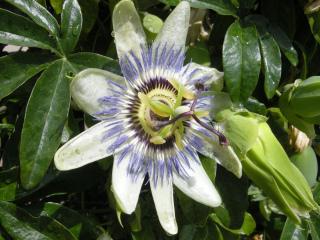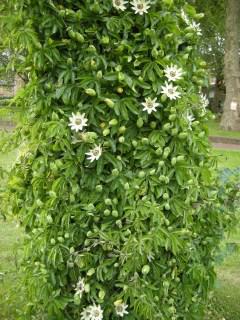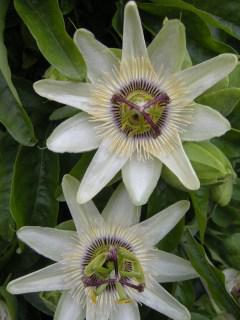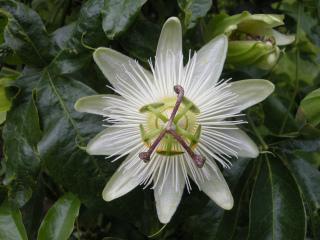
Passiflora caerulea Flower (07/07/2012, London)
Position: Full sun to light shade
Flowering period: Summer to early autumn
Soil: Moist, well drained
Eventual Height: 12m
Eventual Spread: 3m
Hardiness: 6a – 10b
Family: Passifloraceae

Passiflora caerulea ‘White Lightning’ (07/07/2012, London)
Passiflora caerulea is a large vigorous semi-evergreen climbing vine. Its dark green leaves are alternate, palmately five lobed with entire margins and up to 10cm across. At the base of each leaf a twining tendril is found, this is up to 10cm long and enables this plant to cling to suitable supports. Its stem is woody. Its distinctive waxy fragrant flowers are up to 10cm across, white in color with white and blue filaments arranged in a circle at its center. Its fruit is an orange berry, up to 6cm long and 4cm across, contains numerous seeds in a red pulp and persists throughout the winter months.
Passiflora caerulea, commonly known as the Passion Flower or Blue Passion Flower, is native to central and western South America. It is the national flower of Paraguay.

Passiflora caerulea ‘White Lightning’ Flower (07/07/2012, London)
The etymological root of the binomial name Passiflora is derived from the Latin passio meaning ‘passion’ and flos meaning ‘flower, in reference to parts of this plant seemingly representing aspects of Christ. Caerulea is from the Latin meaning ‘blue’, in reference to the filaments of the flowers.
The landscape architect may find Passiflora caerulea useful as a fast growing semi-evergreen climber with exotic flowers. It will require a support for its tendrils to twine around.
Ecologically, P. caerulea is attractive to pollinating insects. Its fruit is attractive to some mammals and birds for its seedy pulp.
The Royal Horticultural Society has given P. caerulea their prestigious Award of Garden Merit in 1993.

Passiflora caerulea ‘Constance Elliott’ Flower (15/07/2012, London)
P. caerulea prefers moist, fertile, well-drained soils. It tolerates most pH of soil.
Passiflora caerulea requires little maintenance.

